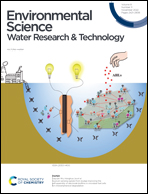Emerging investigator series: environment-specific auxiliary substrates tailored for effective cometabolic bioremediation of 1,4-dioxane†
Abstract
Cometabolic bioremediation is trending for the treatment of 1,4-dioxane (dioxane) and other emerging contaminants to meet stringent regulatory goals (e.g., <10 μg L−1) since biodegradation activities can be fueled by the supplementation of auxiliary substrates. In this study, we compared and investigated the effectiveness of two types of common auxiliary substrates, short-chain alkane gases (e.g., propane and butane) and primary alcohols (e.g., 1-propanol, 1-butanol, and ethanol), for dioxane removal in diverse environmental matrices with Azoarcus sp. DD4 as the inoculum. Physicochemical characterization at the pure culture level revealed that propane and 1-propanol are advantageous for stimulating cell growth and dioxane biodegradation by DD4. Parallel microcosm assays were conducted to assess the compatibility of DD4 bioaugmentation in diverse microbiomes recovered from five different environmental samples, including shallow and deep aquifer groundwater, contaminated river sediment, and municipal activated sludge. Propane was effective in sustaining efficient dioxane removal and the dominance of DD4 across all environmental matrices. Notably, amendment with 1-propanol promoted superior dioxane degradation in the deep aquifer groundwater, in which low pre-treatment biomass and post-treatment diversity were observed, suggesting its potential for intrinsic field applications. The combination of microbial community analysis and differential ranking identified that Ochrobactrum and several other indigenous bacteria were boosted by the inoculation of DD4, implying their commensal or mutualistic relationship. Collectively, propane and 1-propanol can be effective auxiliary substrate alternatives tailored for in situ bioaugmentation and their effectiveness is affected by the density and structure of environmental microbiomes.

- This article is part of the themed collection: Emerging Investigator Series


 Please wait while we load your content...
Please wait while we load your content...